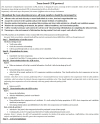Improve Cardiac Emergency Preparedness by Building a Team-Based Cardiopulmonary Resuscitation Educational Plan
- PMID: 35874986
- PMCID: PMC9300942
- DOI: 10.3389/fpubh.2022.895367
Improve Cardiac Emergency Preparedness by Building a Team-Based Cardiopulmonary Resuscitation Educational Plan
Abstract
Objective: To design an innovative team-based cardiopulmonary resuscitation (CPR) educational plan for multiple bystanders and evaluate whether it was associated with better teamwork and higher quality of resuscitation.
Methods: The team-based CPR plan defined the process for a three-person team, emphasize task allocation, leadership, and closed-loop communication. Participants qualified for single-rescuer CPR skills were randomized into teams of 3. The teamwork performance and CPR operation skills were evaluated in one simulated cardiac arrest scenario before and after training on the team-based CPR plan. The primary outcomes were measured by the Team Emergency Assessment Measure (TEAM) scale and chest compression fraction (CCF).
Results: Forty-three teams were included in the analysis. The team-based CPR plan significantly improved the team performance (global rating 6.7 ± 1.3 vs. 9.0 ± 0.7, corrected p < 0.001 after Bonferroni's correction). After implementing the team-based CPR plan, CCF increased [median 59 (IQR 48-69) vs. 64 (IQR 57-71%)%, corrected p = 0.002], while hands-off time decreased [median 233.2 (IQR 181.0-264.0) vs. 207 (IQR 174-222.9) s, corrected p = 0.02]. We found the average compression depth was significantly improved through the team-based CPR training [median 5.1 (IQR 4.7-5.6) vs. 5.3 (IQR 4.9-5.5) cm, p = 0.03] but no more significantly after applying the Bonferroni's correction (corrected p = 0.35). The compression depths were significantly improved by collaborating and exchanging the role of compression among the participants after the 6th min.
Conclusion: The team-based CPR plan is feasible for improving bystanders teamwork performance and effective for improving resuscitation quality in prearrival care. We suggest a wide application of the team-based CPR plan in the educational program for better resuscitation performance in real rescue events.
Keywords: bystander; cardiopulmonary resuscitation; emergency preparedness; out-of-hospital cardiac arrest; teamwork.
Copyright © 2022 Xu, Dong, Yin, Guan, Li, Qu, Chen, Wang, Fang and Zhang.
Conflict of interest statement
The authors declare that the research was conducted in the absence of any commercial or financial relationships that could be construed as a potential conflict of interest.
Figures



Similar articles
-
Tele-Instruction Tool for Multiple Lay Responders Providing Cardiopulmonary Resuscitation in Telehealth Emergency Dispatch Services: Mixed Methods Study.J Med Internet Res. 2023 Jul 26;25:e46092. doi: 10.2196/46092. J Med Internet Res. 2023. PMID: 37494107 Free PMC article. Clinical Trial.
-
Optimal paramedic numbers in resuscitation of patients with out-of-hospital cardiac arrest: A randomized controlled study in a simulation setting.PLoS One. 2020 Jul 7;15(7):e0235315. doi: 10.1371/journal.pone.0235315. eCollection 2020. PLoS One. 2020. PMID: 32634172 Free PMC article. Clinical Trial.
-
Effect of Face-to-Face vs Virtual Reality Training on Cardiopulmonary Resuscitation Quality: A Randomized Clinical Trial.JAMA Cardiol. 2020 Mar 1;5(3):328-335. doi: 10.1001/jamacardio.2019.4992. JAMA Cardiol. 2020. PMID: 31734702 Free PMC article. Clinical Trial.
-
Teamwork and leadership in cardiopulmonary resuscitation.J Am Coll Cardiol. 2011 Jun 14;57(24):2381-8. doi: 10.1016/j.jacc.2011.03.017. J Am Coll Cardiol. 2011. PMID: 21658557 Review.
-
Improving bystander cardiopulmonary resuscitation.Curr Opin Crit Care. 2011 Jun;17(3):219-24. doi: 10.1097/MCC.0b013e32834697d8. Curr Opin Crit Care. 2011. PMID: 21499092 Review.
Cited by
-
Tele-Instruction Tool for Multiple Lay Responders Providing Cardiopulmonary Resuscitation in Telehealth Emergency Dispatch Services: Mixed Methods Study.J Med Internet Res. 2023 Jul 26;25:e46092. doi: 10.2196/46092. J Med Internet Res. 2023. PMID: 37494107 Free PMC article. Clinical Trial.
References
-
- Ho AFW, De Souza NNA, Blewer AL, Wah W, Shahidah N, White AE. Implementation of a national 5-year plan for prehospital emergency care in singapore and impact on out-of-hospital cardiac arrest outcomes from 2011 to 2016. J Am Heart Assoc. (2020) 9:e015368. 10.1161/JAHA.119.015368 - DOI - PMC - PubMed
Publication types
MeSH terms
LinkOut - more resources
Full Text Sources
Medical

